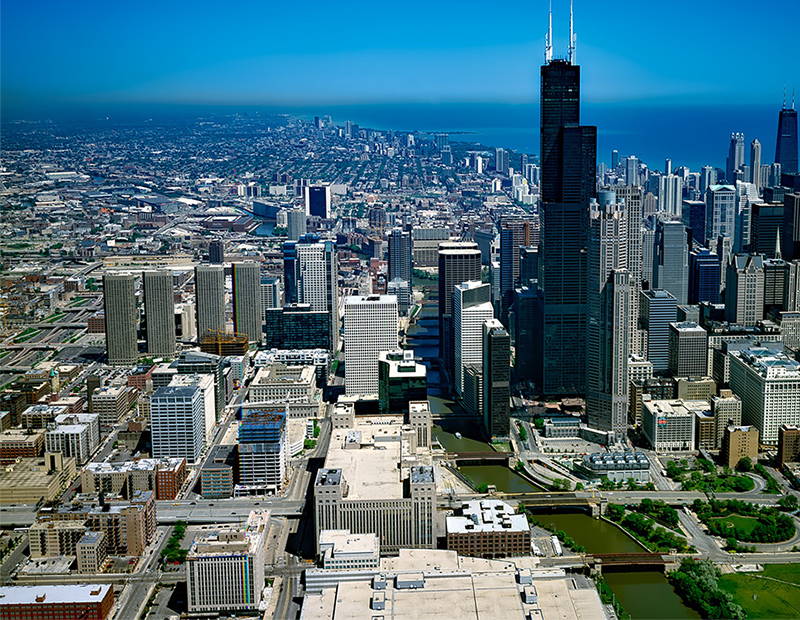Chicago’s Industrial Corridor Renaissance
The North Branch Industrial Corridor is part of local authorities’ Industrial Corridor Modernization Initiative, a multi-year effort to review the city’s designated industrial areas. Baker Development Corp. Principal Dan Slack spoke to CPE about how the rezoning impacts development along the Chicago River.
By Laura Calugar

Chicago River
Chicago’s steady development boom and its evolution as one of the country’s top tech hubs have brought winds of change in the city’s land use strategy. Mayor Rahm Emanuel’s landmark plan to modernize the North Branch Industrial Corridor passed last summer, bringing much-awaited adjustments. The North Branch Industrial Corridor—which stretches from Kinzie Street to north of Fullerton Avenue, along the Chicago River—is the first of 26 industrial areas across the city to get a modernization plan that will oversee development for decades to come.
The new strategy paves the way for residential and commercial projects since it establishes contemporary zoning regulations for the 760-acre corridor, which will enable it to evolve as a mixed-use business center. Prior to this reform, many large land parcels were set aside for manufacturers that no longer did business there, impeding new real estate development.
The need for change
In an effort to protect the city’s industrial base from the intrusion of residential and non-manufacturing projects, the city of Chicago designated several industrial corridors and Planned Manufacturing Districts (PMDs) in the 1980s. But as the city evolved and the effects of technology began to be more conspicuous, industrial opportunities declined. Currently, the North Branch Industrial Corridor includes four PMDs, which encompass 620 acres. Many manufacturers decided to relocate once the area began to favor less industrial operations, abandoning their facilities.
Chicago’s new plan enables new residential and commercial uses. The exception is the 60-acre industrial portion of Goose Island, home to Wrigley Corp.’s Global Innovation Center and UI Labs. One of the main changes in the corridor’s zoning is that mixed-use development is now allowed in northern and southern parts. The northern portion of the North Branch was changed to manufacturing and the southern portion to downtown service, which will facilitate uses that were prohibited by PMD zoning.
The newly created Industrial Corridor System Fund will support industrial development projects throughout the city. Developers will pay fees to back the fund. Moreover, the Neighborhood Opportunity Bonus system was expanded to the southern portion of the corridor and a North Branch Corridor Bonus system in the northern part of the corridor was created. The latter will permit developers to make voluntary payments in exchange for increased density for new development projects.
The impact of reforms

Daniel Slack, Baker Development Corp.
Chicago-based Baker Development Corp. foresaw demand for office space in and around the North Branch Industrial Corridor before the new land use guidelines were adopted last year. Located within the boundaries of the rezoned corridor, 2017 Mendell is a 62,000-square-foot Class A office building in the emerging Lincoln Yards mixed-use district, that the company began work on in 2016. The Mendell project reflects the evolution of property uses along this stretch of the Chicago River. In order to understand how developers see all these changes, Commercial Property Executive talked with Baker Development Corp. Principal Daniel Slack.
Tell us more about how land use in Chicago evolved since 1990.
Daniel Slack: Residential is really the main driver related to the exodus of manufacturing and the change in zoning—the residential growth pattern that was pervasive was no longer compatible with the industrial/manufacturing districts (old PMDs) put in place to protect blue-collar jobs. The industry got tired of the complaints and the smart ones waited just long enough as they saw the dollar signs dangled in their face. It’s kind of a natural transformation coming out of a fundamental paradigm shift.
How imperative was it to make changes to the area’s zoning?
Slack: It was imperative to allow development to proceed, but the shift was going to happen regardless—the only difference is that you may have been looking at empty industrial buildings until the zoning caught up with the inevitable change in land use, which wouldn’t have been a good thing.
What kind of public improvements would help developers most in the area?
Slack: Transportation—whether public or private and transportation corridors such as bridges and tunnels/infrastructure. East-West travel is already difficult in this area and it is only going to get worse given the amount of density that is going to be added in the future. We need bike/pedestrian paths, widened roads and added bridges. We also need effective public local transportation to get to hubs for the L/CTA and Metra Rail.
How much do you expect the area to transform during the next decade following the new land uses?
Slack: It will be fairly dramatic. The only thing standing in the way is a natural slowdown that would come on the heels of a normal economic cycle, but the potential for growth is exponential. The huge demand fueled by the reurbanization of Chicago and the paradigm shift outlined above, coupled with the change in zoning in the North Branch corridor, left the perfect void to be filled by commercial and residential development.
Images courtesy of Baker Development Corp. and Structured Development







You must be logged in to post a comment.